When you buy through our links, we may earn a commission. Products or services may be offered by an affiliated entity. Learn more.
While quality sleep benefits everyone, it’s especially important for teenagers. Consistent and high-quality sleep promotes brain function, school performance, physical health, mood, and decision-making. And having the right mattress means one less barrier to a healthy sleep routine.
Our Top Picks
-
Best Mattress Overall – Nectar Classic
View Details
-
Most Comfortable Mattress – WinkBed
View Details
-
Best Mattress for Side Sleepers – Helix Midnight
View Details
-
Best Mattress for Lighter Teens – Nolah Original 10
View Details
-
Best Mattress for Heavier Teens – Titan Plus Core
View Details
Swipe for more
Best Mattress Overall
Nectar Classic
8.3 /10
Test Lab Score
Save up to 50% on mattresses + 15% off regular prices
Save up to 50% on mattresses + 15% off regular prices
Teens looking for a comfortable and dependable mattress could do a lot worse than the Nectar, a memory foam model that offers plush contouring over a resilient foam core. It’s budget-friendly and it’s not super heavy, so it’s easy to pack when they move out. Nectar offers a generous 365-night trial, enough to see how it holds up through a growth spurt.
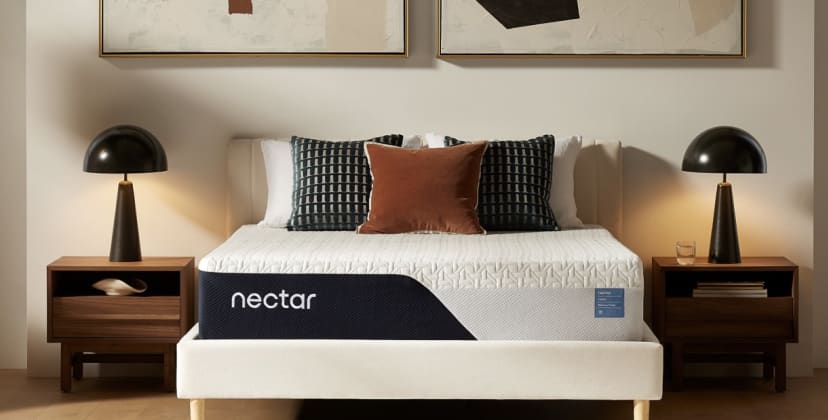
Price
$649
Mattress Type
Foam
Firmness Options
Medium Firm (6)
Trial Period
365 nights (30-night requirement)
At a Glance
- Who It’s Best For: Side and back sleepers.
- Feel: Medium firm (6): memory foam conforms fairly closely without sinking too much.
- What It’s Made Of: The top layer is 2 inches of pressure-relieving gel memory foam, followed by 3 inches of firmer transitional polyfoam and a 7-inch polyfoam support core. Cover is made with polyethylene fibers.
- What We Don’t Like: May sleep hot or restrict movement. A little on the soft side for stomach sleepers, particularly those over 230 pounds.
Scoring & Reviews
The following ratings show how suitable this mattress is for different sleeping positions and sleeper weights. These scores are determined by how well the mattress supports and relieves pressure for each sleeper type.
We performed a meta-analysis on 10000 validated customer reviews of the Nectar Mattress. This is what people who bought the mattress had to say:- Pain Relief: Many users have reported significant relief from back, neck, and joint pain. The mattress seems particularly beneficial for those with chronic pain, contributing to better overall sleep quality.
- Free Accessories: Nectar often includes free pillows, mattress protectors, and sheets with the mattress, adding value and convenience for new customers.
- Suitable for All Weights: The mattress supports a wide range of body weights and sizes without losing comfort or stability, making it versatile for different users.
- Temperature Regulation: Several reviews indicate that the mattress does a good job of staying cool throughout the night, which is a significant benefit for those who tend to sleep hot.
- Customer Service: Positive remarks about Nectar’s customer service are common, with many customers feeling supported during the purchasing and setup process.
- Durability Concerns: While many users find the mattress supportive and comfortable, there are occasional mentions of durability concerns, such as sagging or indentations developing over time, particularly from heavier users.
Full Details
Construction Breakdown
The Nectar’s topmost layer consists of solid memory foam. This material contours evenly to distribute your teen’s weight, promote even alignment, and reduce pressure buildup in the shoulders, lower back, and hips. The mattress’ adaptive feel can be particularly beneficial for athletes and other teens with physically active lifestyles. Cooling gel is infused into the memory foam to prevent overheating at night.
Two layers of dense polyfoam provide a stable base, giving the mattress a medium firm (6) feel.
Trial, Shipping, Warranty
Nectar allows each customer to test out the mattress for up to 365 nights. This ensures plenty of time for your teen to decide whether or not the mattress meets their needs. If they decide to keep it, you’ll also receive a lifetime warranty covering structural and material defects as long as you retain original ownership.
Best Value Mattress
Brooklyn Bedding CopperFlex Memory Foam
8.6 /10
Test Lab Score
30% off sitewide
30% off sitewide
Brooklyn Bedding’s CopperFlex Memory Foam is an affordable mattress that offers strong performance and great long-term value for owners. Plush foam layers and a sturdy base create a balanced, medium firm (6) feel that most teens will find comfortable and supportive in equal measure.

Credit: Sleep Foundation Test Lab
Price
$466
Mattress Type
Foam
Firmness Options
Medium Firm (6)
Trial Period
120 nights (30-night requirement)
At a Glance
- Who It’s Best For: Side sleepers who weigh at least 130 pounds, back sleepers who weigh up to 230 pounds, or side and back positions who weigh 130 to 230 pounds, as well as hot sleepers.
- Feel: Medium firm (6) with a plush surface and close contouring without excess sinkage.
- What It’s Made Of: Adaptive polyfoam quilted to the cover, two memory foam layers, and transitional foam divided into zones. Copper fibers in the top memory foam layers and GlacioTex fabric in the cover. Two high-density polyfoam layers in the support system.
- What We Don’t Like: Some strong odor for up to 72 hours after unboxing. May lack support for teens who sleep on their stomachs — especially those who weigh over 130 pounds.
Scoring Breakdown
The following ratings show how suitable this mattress is for different sleeping positions and sleeper weights. These scores are determined by how well the mattress supports and relieves pressure for each sleeper type.
We performed a meta-analysis on 549 validated customer reviews of the Brooklyn Bedding CopperFlex Memory Foam. This is what people who bought the mattress had to say:- Pricing and Value: Many reviewers have highlighted that the mattress is affordable and offers great value for the price, making it an excellent choice for budget-conscious shoppers.
- Heat Regulation: Several users noted that the mattress does not retain much heat, which contributes to a cooler and more comfortable sleep, especially for those who tend to sleep hot.
- Edge Support: The mattress is reported to have good edge support, which is beneficial for those who use the edge of the bed frequently or sleep close to the sides.
- Odor and Off-Gassing: Some reviews mention that the mattress has minimal off-gassing odor upon unpacking, which is a common concern with new mattresses. The smell will dissipate in a few days.
- Hybrid Option: The availability of hybrid models is appreciated, particularly for those needing more support, such as individuals with larger frames.
- Customer Service: Positive remarks about customer service suggest that the company handles queries and issues effectively.
Full Details
Construction Breakdown
The CopperFlex mattress features six distinct layers, starting with a thin strip of adaptive polyfoam quilted into the cover. Two layers of memory foam offer a plush, contouring feel, while a copper fiber infusion helps maintain a cooler sleep temperature.
The transitional foam is designed with three firmness zones, providing extra support under your torso and hips. For stability, the support core includes two high-density polyfoam layers. The cover is made of GlacioTex fabric, which is engineered to absorb and dissipate body heat upon contact.
Trial, Shipping, & Warranty
Customers in the contiguous U.S. receive free ground shipping with their CopperFlex Memory Foam mattress purchase. Brooklyn Bedding offers a 120-night sleep trial, which includes a 30-night break-in period before returns can be made. If you decide to keep the mattress after the trial, it’s protected by a lifetime manufacturer’s warranty.
Most Comfortable Mattress
WinkBed
9.4 /10
Test Lab Score
30% off all WinkBeds mattresses
30% off all WinkBeds mattresses
The WinkBed has a well-balanced construction that maximizes the benefits of the pressure-relieving foams in the comfort layers, while adding all the benefits of a hybrid: airflow, edge support, and bounce. It also includes several reinforcing features for the lumbar spine to prevent back pain when back or side sleeping.
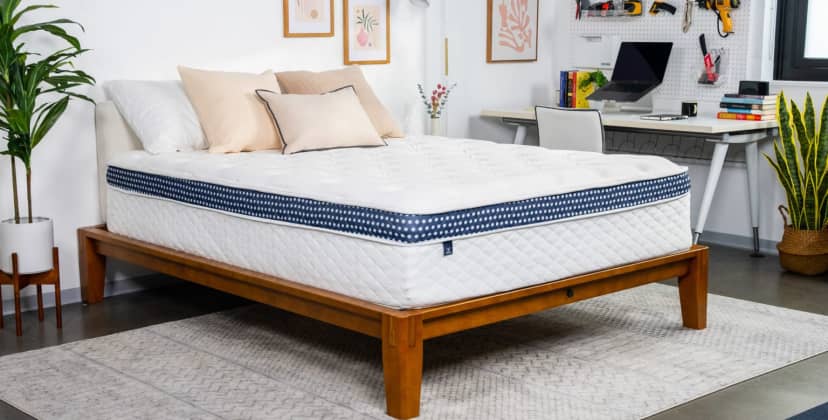
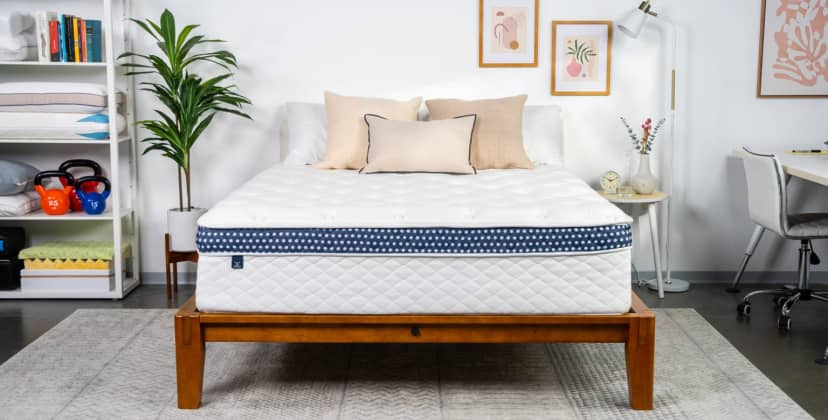
Credit: Sleep Foundation Test Lab
Price
$2,570
Mattress Type
Innerspring
Firmness Options
Medium Soft (4), Medium Firm (6), Firm (7), Firm (8)
Trial Period
120 nights (30 night requirement)
At a Glance
- Who It’s Best For: Most teens, depending on firmness level.
- Feel: Medium soft (4), medium firm (6), firm (7), and firm (8) options. Initial cloud-like feeling, with a healthy level of bounce and more or less sink, depending on the firmness.
- What It’s Made Of: Moisture-wicking Tencel cover and a Euro-top with layers of gel foam or latex. The core is made with pocketed coils.
- What We Don’t Like: Might require deep pocket fitted sheets. Bulky and heavy. Mattress exchanges for a different firmness level cost $49.
Scoring & Reviews
The following ratings show how suitable this mattress is for different sleeping positions and sleeper weights. These scores are determined by how well the mattress supports and relieves pressure for each sleeper type.
We performed a meta-analysis on 8573 validated customer reviews of the Winkbed. This is what people who bought the mattress had to say:- Pain Relief and Support: A significant number of users report alleviation of back, hip, and shoulder pain, attributing this to the mattress’s supportive design. Individuals with chronic back issues have noted substantial improvements in sleep quality.
- Comfort Across Sleep Positions: Reviewers from various sleep positions—side, back, and stomach—find the mattress comfortable. The availability of different firmness levels allows users to select options that best suit their sleeping style.
- Temperature Regulation: Many customers appreciate the mattress’s ability to stay cool, enhancing overall comfort throughout the night.
- Edge Support: Users frequently mention the robust edge support, which provides a stable and usable sleeping surface across the entire mattress.
- Firmness Options: Customers appreciate the variety of firmness options available, finding the right balance for their personal preferences.
- Durability and Craftsmanship: The mattress is often praised for its high-quality construction and materials, with users expressing confidence in its longevity. The lifetime warranty further reinforces trust in the product’s durability.
- Customer Service and Trial Experience: Customers value the 120-night risk-free trial and responsive customer service, noting that these factors contribute to a positive purchasing experience.
Full Details
How It Performed
The softer models cushion tender areas for side sleepers and people under 130 pounds, while the firmer models offer more support for back and stomach sleepers. The mattress is also highly suitable for combination sleepers, who enjoy excellent ease of movement on the firmer models especially.
Construction Breakdown
The standard WinkBed features a layer of adaptive foam quilted into its Euro-top covers, followed by a second foam layer that contours evenly while keeping the body on an even plane. If your teen weighs more than 230 pounds, the WinkBed Plus (8) may be more suitable. This model swaps out the second foam layer for 2.5 inches of zoned latex, ensuring extra pushback for heavier areas of the body like the chest, stomach, and hips.
All versions of the WinkBed are constructed with pocketed coil support cores. The coils are also zoned to feel firmer and more robust beneath the midsection, and perimeter reinforcement reduces sinkage when your teen sleeps or sits along the mattress’ edges. A cover made of breathable, moisture-wicking Tencel fabric encases the WinkBed.
Trial, Shipping, & Warranty
WinkBeds offers free ground shipping across the contiguous U.S. The mattress comes with a 120-night sleep trial. If your teenager is not satisfied with the WinkBed after sleeping on it for 30 nights, they may exchange the mattress for a softer or firmer model at no extra cost. The replacement comes with its own 60-night trial period. A lifetime warranty against structural defects is also included with your purchase.
Best Mattress for Side Sleepers
Helix Midnight
9.1 /10
Test Lab Score
25% off sitewide
25% off sitewide
Helix offers a collection of mattresses that are curated to specific sleep positions, with the Midnight being intended for side sleepers. Soft foams cradle the hips and shoulders to prevent pressure buildup, while the coil layer provides standout edge support and airflow.
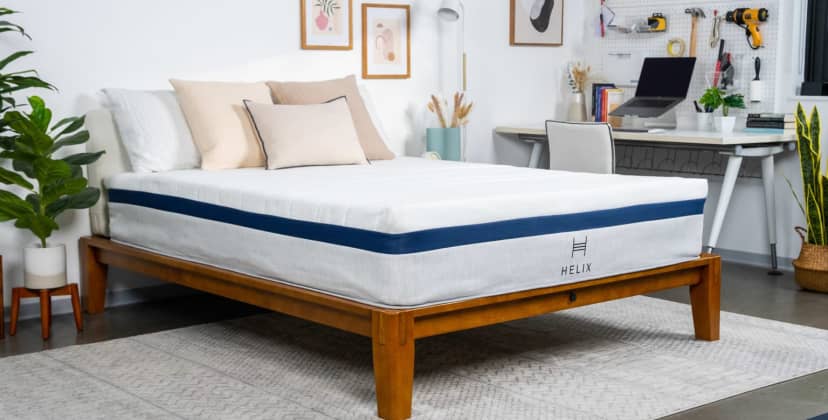
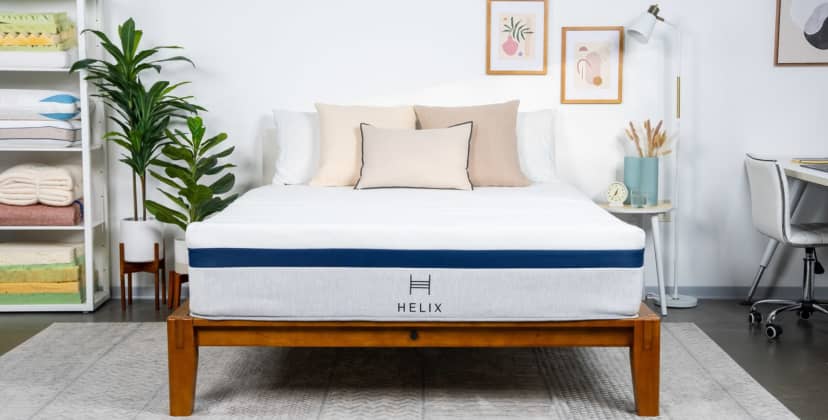
Credit: Sleep Foundation Test Lab
Price
$1,099
Mattress Type
Hybrid
Firmness Options
Medium Firm (6)
Trial Period
120 nights (30-night requirement)
At a Glance
- Who It’s Best For: Side and back sleepers, as well as hot sleepers.
- Feel: Medium firm (6). Comfortable and cushiony with an overall responsive feel.
- What It’s Made Of: Memory foam and polyfoam comfort section over a support core of reinforced, pocketed coils. Standard, breathable knit cover or options cooling pillow-top.
- What We Don’t Like: Might be too soft for teen stomach sleepers.
Scoring & Reviews
The following ratings show how suitable this mattress is for different sleeping positions and sleeper weights. These scores are determined by how well the mattress supports and relieves pressure for each sleeper type.
We performed a meta-analysis on 6653 validated customer reviews of the Helix Midnight. This is what people who bought the mattress had to say:
- Comfort and Firmness: Most reviewers praised the mattress for its medium-firm feel, which strikes a balance between support and plushness. Side sleepers in particular reported enhanced comfort due to effective cradling of pressure points.
- Heat Regulation: While many found the mattress sufficiently cool, some customers noted slight heat retention, which is typical for mattresses with foam comfort layers.
- Pain Relief: A standout theme was relief from back, hip, and shoulder pain. Customers with chronic pain or those who sleep on their sides frequently noted a reduction in discomfort.
- Durability Concerns: A minority of reviewers reported early signs of sagging or indentations, raising concerns about long-term durability.
- Sleep Quality: Numerous customers mentioned improved sleep quality, citing deeper, uninterrupted rest as a key benefit.
- Edge Support: Reviews indicated mixed opinions, but the mattress generally supports weight well at the edges, aligning with what hybrid beds typically offer.
Full Details
Construction Breakdown
The mattress begins with a top layer of memory foam that conforms closely to the body, followed by a layer of polyfoam that feels firmer than the memory foam while still offering some contouring. The support core contains pocketed coils that give the bed a slightly bouncy feel, and the reinforced perimeter provides very good edge support. The cover is made of a polyester fabric that is breathable and slightly stretchy.
Trial, Shipping, & Warranty
Helix ships mattresses for free to all 50 states. The bed includes a 120-night sleep trial with a required 30-day break-in period. Customers receive a lifetime warranty.
Best Mattress for Combination Sleepers
Brooklyn Bedding Signature Hybrid
8.4 /10
Test Lab Score
30% off sitewide
30% off sitewide
The Brooklyn Bedding Signature Hybrid is offered in three different firmness options. The bed uses resilient foams and coils that provide a good level of bounce, enabling teens to easily switch positions. The mattress has a breathable design and all three models deliver strong edge support.
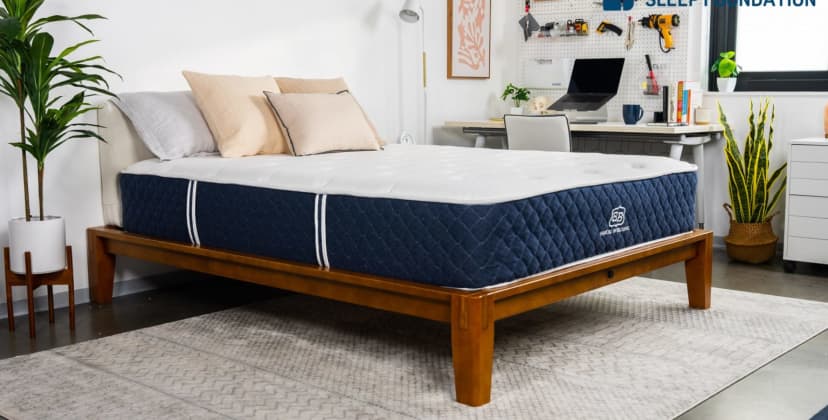
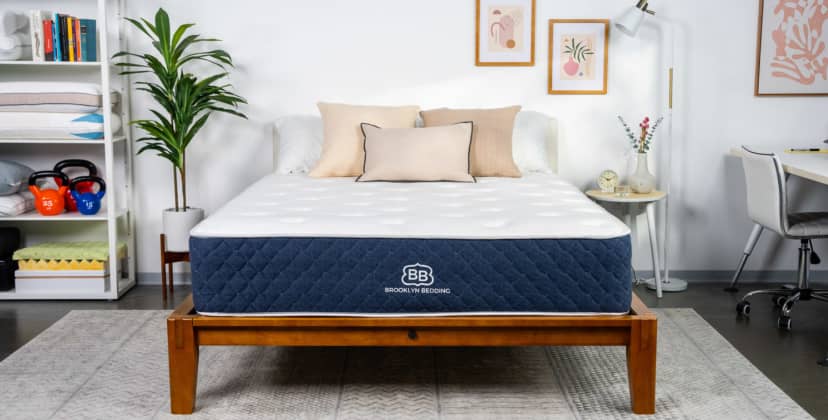
Credit: Sleep Foundation Test Lab
Price
$999
Mattress Type
Hybrid
Firmness Options
Medium Soft (4), Medium Firm (6), Firm (8)
Trial Period
120 nights (30-night requirement)
At a Glance
- Who It’s Best For: Side sleepers (softer model), back sleepers (medium model), and stomach sleepers (firmest model).
- Feel: Medium soft (4), medium firm (6), and firm (8) models, all of which keep the spine on an even plane.
- What It’s Made Of: Features 1.5 inches of quilting, followed by two layers of responsive foams. An 8-inch layer of pocketed coils rests atop a thin layer of base foam with stronger coils around the edges.
- What We Don’t Like: Return fee of $99.
Scoring & Reviews
The following ratings show how suitable this mattress is for different sleeping positions and sleeper weights. These scores are determined by how well the mattress supports and relieves pressure for each sleeper type.
We performed a meta-analysis on 11,922 validated customer reviews of the Brooklyn Bedding Signature Hybrid. This is what people who bought the mattress had to say:- Comfort and support: Many reviewers mention that the mattress is very comfortable and provides good support for various sleeping positions.
- Improvement in sleep quality: Several users report a significant improvement in sleep quality, including better rest and reduced pain.
- Firmness options: People appreciate the availability of different firmness levels, and some discuss their experiences with medium, firm, or pillow-top options.
- RV suitability: A number of reviews specifically mention using the mattress in RVs, noting it as a substantial upgrade from typical RV mattresses.
- Initial odor/smell: Some reviewers note a mild odor upon unpacking, but it typically dissipates quickly.
- Edge support: The mattress is often noted for having good edge support, which is particularly valued by those who sit on the edge of the bed.
- Price and value: Many reviewers feel the mattress is well-priced for the quality and comfort it provides.
- Durability concerns: A few reviewers express concerns about how the mattress will hold up over time, although these comments are not widespread.
Full Details
Construction Breakdown
Each Signature Hybrid begins with a top layer of TitanFlex polyfoam, a material that offers the same even cradling as memory foam without the deep hug. Medium soft and medium firm models also feature a layer of plush adaptive foam quilted into their covers. VariFlex transitional foam mimics the responsiveness of natural latex, producing a light bounce when your teen gets into bed. This helps them move across the surface without feeling stuck. The hybrid’s support core consists of pocketed coils and dense base foam.
The standard model comes with a cover made from breathable cotton. For an extra fee, you can upgrade the mattress to include an extra foam layer encased in GlacioTex fabric, a material engineered to dissipate body heat on contact and feel cool to the touch at all times. This add-on also makes the surface feel slightly softer. Teens who run hot in bed may need this component to sleep comfortably.
Trial, Shipping, & Warranty
The Signature Hybrid’s sticker price falls well below average for a hybrid model, and standard ground shipping is free for customers in the contiguous U.S. Each order comes with a 120-night sleep trial, giving your teen roughly four months to decide whether the mattress is right for them. If they’re satisfied with how the bed feels, your purchase is further backed by a lifetime warranty.
Best Mattress for Lighter Teens
Nolah Original 10
8.0 /10
Test Lab Score
35% off sitewide + extra $100 off with code: SF100
35% off sitewide + extra $100 off with code: SF100
This plush foam mattress offers targeted pressure relief for side sleepers, with zoned polyfoam that’s softer in the shoulders and firmer in the middle third of the bed. The all-foam design is great for teens under 230 pounds and provides surprisingly good edge support thanks to the thin comfort system.
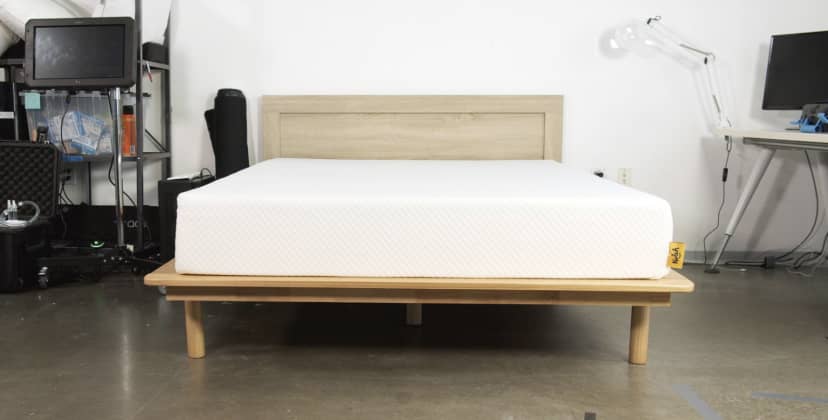

Credit: Sleep Foundation Test Lab
Price
$942
Mattress Type
Foam
Firmness Options
Medium (5)
Trial Period
120 nights (30-night requirement)
At a Glance
- Who It’s Best For: Side sleepers weighing less than 230 pounds.
- Feel: Medium (5) feel. Sleepers sink into the top 2 inches before coming to rest on the polyfoam core, which offers support without feeling too firm.
- What It’s Made Of: Breathable Tencel cover, a 2-layer foam comfort system, and a support core with 8 inches of polyfoam.
- What We Don’t Like: May retain heat, restrict movement, and provide insufficient support for sleepers over 230 pounds. Return fee of $99.
Scoring & Reviews
The following ratings show how suitable this mattress is for different sleeping positions and sleeper weights. These scores are determined by how well the mattress supports and relieves pressure for each sleeper type.
Full Details
Construction Breakdown
The Nolah Original 10 uses three different foam layers to deliver targeted pressure point relief and motion isolation. The top layer is crafted from patented AirFoam, a polyfoam that limits heat retention by promoting air circulation. This layer contours closely to your body but still has some pushback, which is ideal for sleepers who prefer the feeling of sleeping “on” instead of “in” their mattress.
The middle polyfoam layer also contributes to this feeling, acting as a buffer that prevents you from sinking too deeply into the mattress. The high-density polyfoam support core is quite durable and meant to enhance the foam layers above it. A Tencel cover wraps the mattress, helping to wick moisture away while you sleep.
Trial, Shipping, & Warranty
Teens who toss and turn may have an easier time sleeping through the night because of how well this model isolates motion. Movement is trapped within the foam layers instead of transferred across them, creating a more relaxing sleep surface.
Best Mattress for Pressure Relief
Layla Memory Foam Mattress
8.4 /10
Test Lab Score
Get an extra $10 off with exclusive code: sleepy10
Get an extra $10 off with exclusive code: sleepy10
All-foam mattresses often excel at pressure relief, and the Layla is no exception. The mattress is flippable, each side conveniently marked with a color-coded cover, so your teen can choose between a firmer or a softer side as they grow and their preferences change. The firm side sleeps exceptionally cool for a foam mattress, while the soft side provides high-level pressure relief.
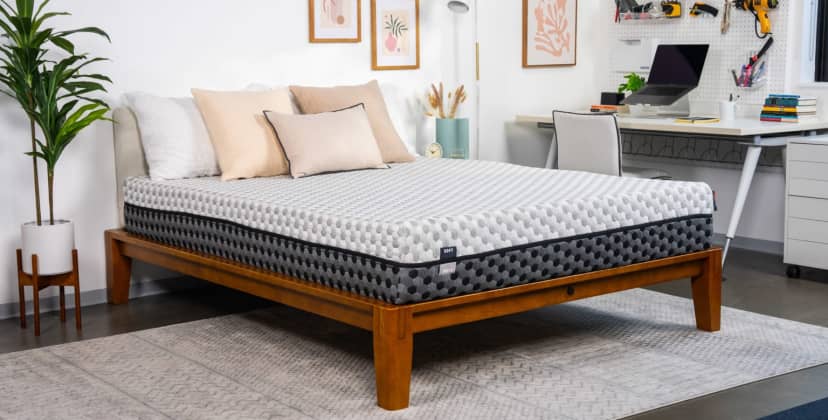
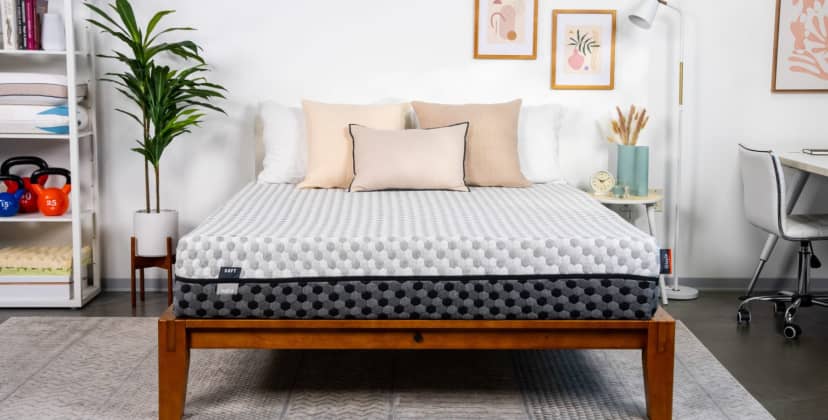
Credit: Sleep Foundation Test Lab
Price
$949
Mattress Type
Foam
Firmness Options
Medium Soft (4), Firm (7)
Trial Period
120 nights (4 week minimum)
At a Glance
- Who It’s Best For: Lightweight side sleepers (soft side) and back sleepers over 130 pounds (firm side).
- Feel: Medium soft (4) side conforms quite closely. Firm side has a hint of cushioning, followed by a firmer, supportive feel.
- What It’s Made Of: Both have a top layer of copper gel memory foam. Soft side features another 2-inch layer of polyfoam. Both share a 4.5-inch polyfoam support core.
- What We Don’t Like: Soft side may buckle at the edges and result in “stuck in bed” feeling when changing positions.
Scoring & Reviews
The following ratings show how suitable this mattress is for different sleeping positions and sleeper weights. These scores are determined by how well the mattress supports and relieves pressure for each sleeper type.
We performed a meta-analysis on 7558 validated customer reviews of the Layla Memory Foam Mattress. This is what people who bought the mattress had to say:- Dual Firmness Options: The Layla Memory Foam Mattress offers both soft and firm sides, allowing users to choose according to their comfort preferences, which is highly appreciated for accommodating different sleeping styles.
- Comfort and Support: Many reviewers have noted the mattress provides exceptional comfort, helping alleviate back pain and improving overall sleep quality. The soft side is often described as cloud-like, while the firm side offers adequate support without being too hard.
- Quality and Durability: Users report that the mattress maintains its shape and comfort over time, with no significant sagging or indentations, even after several years of use, indicating good durability.
- Temperature Regulation: The mattress is generally reviewed as doing a good job of regulating temperature, preventing overheating during sleep, which is a common issue with many memory foam mattresses.
- Ease of Setup: Customers appreciate the ease with which the mattress can be set up. It is delivered in a box and expands quickly once unpacked, making it convenient for immediate use.
- Customer Service: Layla’s customer service receives high praise for being responsive and helpful, aiding customers with issues ranging from delivery to product inquiries and returns.
Full Details
Construction Breakdown
The Layla is a unique reversible design that features a different firmness on each side: medium-soft (4) and firm (7).
Both sides of the mattress feature comfort layers made of memory foam that conforms around the body to evenly distribute weight. The medium-soft side features two layers of foam: memory foam and adaptive polyfoam. The firm side has one thin layer of memory foam.
The foam is infused with copper, which has natural cooling to ensure the material won’t absorb too much heat. Copper is also antimicrobial, which assists with odor control.
The center of the mattress features a high-density polyfoam support core.
Trial, Shipping, & Warranty
The Layla Mattress has a sticker price that’s on par with other memory foam models and shipping is free of charge anywhere in the contiguous U.S. Your purchase will include a 120-night sleep trial and a lifetime warranty against structural defects.
Best Temperature-Regulating Mattress
Leesa Sapira Chill Hybrid
9.0 /10
Test Lab Score
25% off sitewide
25% off sitewide
The Leesa Sapira Chill Hybrid is a great choice for teens who feel pain and pressure in bed, run hot in bed, or sleep close to the edges of their mattress. You can choose from three firmness levels depending on how much your child weighs and which sleep position they prefer.

Credit: Sleep Foundation Test Lab
Price
$1,698
Mattress Type
Hybrid
Firmness Options
Medium (5), Medium Firm (6), Firm (7)
Trial Period
120 nights (30-night requirement)
At a Glance
- Who It’s Best For: Side and back sleepers across most weight groups, teens with frequent back pain, and hot sleepers
- Feel: Available in medium (5), medium firm (6), and firm (7) designs.
- What It’s Made Of: A comfort system with four foam layers encased in a Euro-top, followed by multi-zone pocketed coils and high-density base foam.
- What We Don’t Like: Initial off-gassing odor can be strong and overpowering for the first 72 hours after unboxing.
Scoring & Reviews
The following ratings show how suitable this mattress is for different sleeping positions and sleeper weights. These scores are determined by how well the mattress supports and relieves pressure for each sleeper type.
We performed a meta-analysis on 25 validated customer reviews of the Leesa Sapira Chill Hybrid. This is what people who bought the mattress had to say:- Suitability for Different Sleepers: Several reviews highlight that the mattress is suitable for side sleepers, stomach sleepers, and even for those who experience hip and shoulder pain.
- Temperature Regulation: Some reviews mention the mattress being cool and comfortable, while others complain about it sleeping hot, despite being the “Chill” version.
- Quality and Durability Concerns: A few reviewers express concerns about the mattress’s durability or mention receiving a damaged product.
- Overall Satisfaction: While many reviews are overwhelmingly positive, scoring 5 out of 5, there are a few lower scores where users mention issues like the mattress being too soft, too bouncy, or not meeting expectations in terms of firmness and comfort.
- Specific Needs: Some reviews from users with back pain or who have had long-term use of other mattresses indicate that this model significantly improved their sleep quality and comfort.
Full Details
Construction Breakdown
The Sapira Chill Hybrid features a four-layer comfort system, beginning with 2 inches of adaptive polyfoam sewn to the cover. This material is gel-infused to help the surface maintain a comfy temperature. Additional layers of memory foam and polyfoam add to the Sapira Chill’s cushy feel, while dense transitional foam pushes back against your weight to keep your body on an even plane.
Pocketed coils and high-density base polyfoam make up the support core. The coils are zoned, meaning they feel more robust beneath your torso and hips, and zoned along the perimeter to prevent the edges from compressing too much when you get in and out of bed. At 14 inches thick, the Sapira Chill Hybrid is a high-profile mattress that requires a deep-pocket fitted sheet.
Trial, Shipping, and Warranty
Leesa offers free ground shipping to all 50 states. The Sapira Chill Hybrid comes with a 120-night sleep trial, allowing you to test out the mattress in your own bedroom and decide whether it’s right for you. If you decide to keep the hybrid before the return period ends, it’s also backed by a lifetime manufacturer’s warranty.
Best Mattress for Heavier Teens
Titan Plus Core
8.4 /10
Test Lab Score
30% off sitewide
30% off sitewide
The Titan Plus Core is Brooklyn Bedding’s answer for teens over 230 pounds, with higher-density foams and strong coils. In addition to delivering the extra support needed for this weight group, the sturdy construction also guarantees a cool sleep temperature and a secure perimeter, which is a nice perk for sleepers who are used to feeling unstable when sleeping near the edge of the bed.
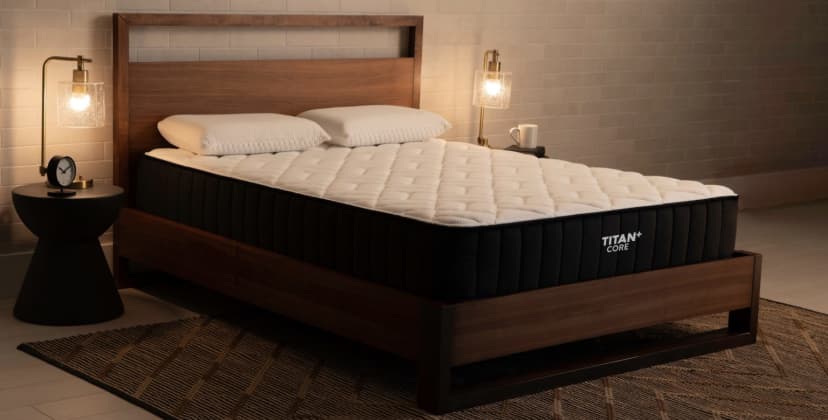
Price
$1,049
Mattress Type
Hybrid
Firmness Options
Firm (8)
Trial Period
120 nights (30-night requirement)
At a Glance
- Who It’s Best For: Side, back, and stomach sleepers over 130 pounds.
- Feel: Firm (8) surface, though may feel medium firm (6) to sleepers over 230 pounds. The quilted cover eases sleepers into the bed and prevents pressure points.
- What It’s Made Of: Cover quilted with one inch of gel foam, followed by 2 inches of dense polyfoam. Support core contains steel pocketed coils and a dense polyfoam base.
- What We Don’t Like: Higher price point and a return fee of $99. Also a heavier mattress.
Scoring & Reviews
The following ratings show how suitable this mattress is for different sleeping positions and sleeper weights. These scores are determined by how well the mattress supports and relieves pressure for each sleeper type.
We performed a meta-analysis on 2753 validated customer reviews of the Titan Plus. This is what people who bought the mattress had to say:- Firmness Level: The Titan Plus is exceptionally firm – some users appreciate this quality, others say the mattress doesn’t provide enough cushioning.
- Supportive for Plus Size: The mattress was originally designed for plus-size people, and many users who fall into this category enjoy the extra reinforcement and pushback.
- Edge Support Issues: Users are generally satisfied with the mattress’s edge support, with most saying they can sit or sleep along the perimeter without feeling like they’re going to roll out of bed.
- Motion Transfer: Some owners who sleep with a partner report strong motion transfer and, in some case, sleep disruptions resulting from movement.
- Odor: Users say the foam layers emit off-gassing smell for the first 24 to 48 hours, but little to no odor after that.
- Positive Customer Service Experiences: Many highlight Brooklyn Bedding’s convenient, mattress-in-a-box delivery system and hassle-free trial period.
Full Details
Construction Breakdown
The Titan Plus Core begins with a top layer of memory foam quilted into the cover. This material adapts to your teen’s body, distributing their weight and cushioning sore spots along the spine, while a second foam layer pushes back against compression to keep them on a flat, even plane. Thick pocketed coils and high-density base foam make up the support core. These components stabilize the mattress quite well, driving home the ultra-firm feel without making the surface feel uncomfortably stiff.
Standard Titan Plus Core models are encased in breathable knit covers. If your teen sleeps exceptionally hot, you can opt for a cover made of GlacioTex fabric. This phase change material is engineered to capture and release body heat on contact for a cool-to-the-touch feel at all times, even on hot or humid nights. Adding the GlacioTex cover will increase the sticker price of your mattress, but only to a marginal extent.
Trial, Shipping, & Warranty
Brooklyn Bedding offers free ground shipping throughout the contiguous U.S. Each Titan Plus Core order includes a sleep trial that runs for 120 nights in length. You may return the mattress for a full refund during this time frame, provided your teen tests it out for at least 30 nights. If they are satisfied with the mattress, you’ll also receive a lifetime warranty against structural defects.
- Adaptive Support: Teenagers are still growing, and a medium-firm mattresses provide balanced support for proper spinal alignment, regardless of sleep position.
- Pressure Relief: To prevent aches and pains, especially in areas like the shoulders, hips, and lower back, mattresses with memory foam or hybrid designs that contour to the body can be particularly effective.
- Temperature Regulation: Teens tend to sleep hot, especially during puberty. Mattresses with cooling features can help keep them cool throughout the night.
- Mattress Size: Teenagers can grow quickly, so choose a mattress size that accommodates their current height and potential growth. While a twin or twin XL is suitable for most teens, those who prefer more space or are taller may benefit from a full or queen.
How We Evaluated & Reviewed
Meta Analysis: Of the 2,000+ mattresses in our product database, roughly 450 are available in twin, twin XL, and full and received an overall rating of 7.5 or higher. Using historical testing data and construction analyses, our team chose the top 30 for additional in-depth evaluations.
Hands-On Testing: In our Seattle Sleep Lab, we had testers lie on each of the top 30 bed and measure how deeply a mattress compresses and how long it takes to return to its original shape. We also used pressure pad mapping technology and a heat gun to test for pressure relief and temperature regulation, respectively.
Field Testing: Next, we sent each bed home with a member of our testing team to sleep on for up to two weeks to gauge how a mattress performs in real-world sleep environment.
User Reviews: We collected data from more than 48,000 verified customer reviews to determine whether our team’s findings match customers’ experiences.
The Best Deals of the Week
-
Save $199
—
Brooklyn Bedding CopperFlex Memory Foam
$466 (List Price $665) -
Save $600
—
Helix Midnight Luxe
$1,799 (List Price $2,399) -
Save $2,436
—
Nectar Adjustable Bundle
$1,398 (List Price $3,834) -
Save $771
—
WinkBed
$1,799 (List Price $2,570) -
Save $1,020
—
DreamCloud Classic Hybrid
$699 (List Price $1,719)
Best Overall
Nectar Classic
8.3 /10
Test Lab Score
Save up to 50% on mattresses + 15% off regular prices
Shop at NectarA solidly built foam mattress that appeals to active and growing teens.
See More Details
Best Value
Brooklyn Bedding CopperFlex Memory Foam
8.6 /10
Test Lab Score
30% off sitewide
Shop at Brooklyn BeddingAn impressively sturdy foam mattress that’s comfortable, resistant to heat buildup, and easy on the wallet.
See More Details

Credit: Sleep Foundation Test Lab
Most Comfortable
WinkBed
9.4 /10
Test Lab Score
30% off all WinkBeds mattresses
Shop at WinkBedsA well-built hybrid with targeted lumbar support and a comprehensive comfort system for teen bodies.
See More Details
Best for Side Sleepers
Helix Midnight
9.1 /10
Test Lab Score
25% off sitewide
Shop at HelixA memory foam hybrid tailored to the needs of teenage side sleepers.
See More Details
Best for Combination Sleepers
Brooklyn Bedding Signature Hybrid
8.4 /10
Test Lab Score
30% off sitewide
Shop at Brooklyn BeddingThree firmness options make this mattress suitable for the vast majority of teen sleepers.
See More Details
Best for Lighter Teens
Nolah Original 10
8.0 /10
Test Lab Score
35% off sitewide + extra $100 off with code: SF100
Shop at NolahA sleek foam mattress that checks all the boxes for teens under 130 pounds.
See More Details

Credit: Sleep Foundation Test Lab
Best for Pressure Relief
Layla Memory Foam Mattress
8.4 /10
Test Lab Score
Get an extra $10 off with exclusive code: sleepy10
Shop at LaylaA lightweight, flippable foam mattress with zoned pressure relief for active teens.
See More Details
Best for Temperature Regulation
Leesa Sapira Chill Hybrid
9.0 /10
Test Lab Score
25% off sitewide
Shop at LeesaA plush, pressure-relieving foam hybrid with three firmness options to choose from.
See More Details
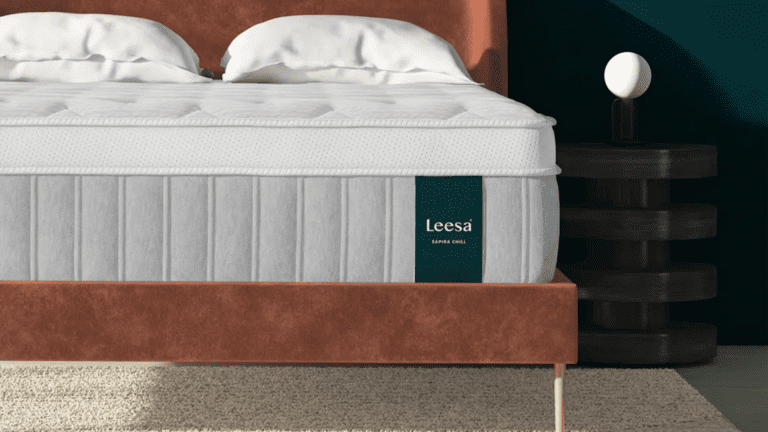
Best for Heavier Teens
Titan Plus Core
8.4 /10
Test Lab Score
30% off sitewide
Shop at TitanHigh-density foams and robust coils engineered to support teens over 230 pounds.
See More Details
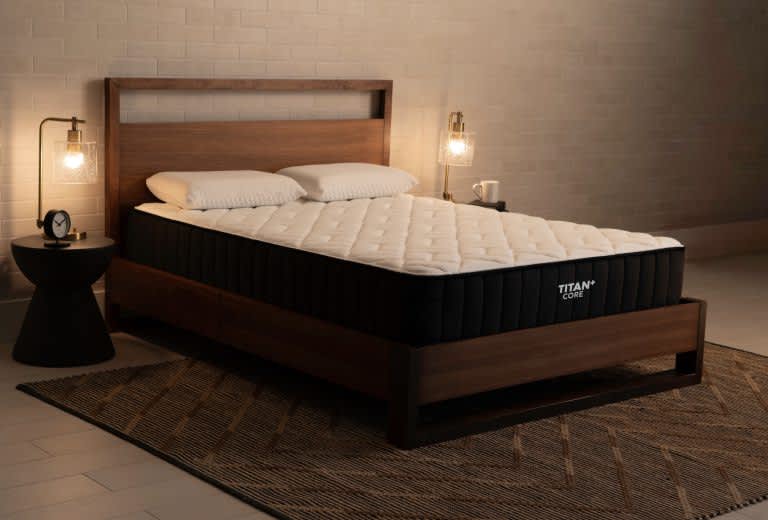
Credit: Sleep Foundation Test Lab
How to Choose a Mattress for Teenagers
When shopping for a mattress, you’ll probably come across lots of mattress terminology and marketing promotions. While it’s easy to be drawn in, you’re most likely to be happy with your purchase if you focus on the nuts and bolts of the mattress.
These factors are essential, and considering which ones matter the most to you lets you shrink your options and clarify which brand and model is the best match for your teen.
Firmness Level
First and foremost, make sure that a mattress feels right. That feel is largely determined by firmness level. A teenager’s personal preference, sleeping position, and body weight can all affect their ideal firmness level. For most teens, a feel of medium soft (4) to medium firm (6) is the best bet.
“It’s vital to support a teen’s growing body with an appropriate, comfortable mattress that encourages them to sleep but does not put undue stress on their growing bodies,” says board-certified pediatrician Nilong Vyas, MD.
Pressure Relief and Contouring
Most teens’ bodies have areas that are prone to growing pains and aches, like the shoulders, legs, and back. A mattress with good contouring — meaning it molds to the body — softens the impact at these pain points and encourages healthy spinal alignment.
Pressure relief is important for teens because their bodies are constantly growing and changing, and it’s especially vital for athletic teens who need ample contouring to help with physical recovery. That’s why we recommend a mattress on the softer end of the spectrum for teens.
Size
A full mattress is usually ideal for teens, because it offers plenty of space to stretch out but doesn’t feel overly spacious for one person. If your teen’s bedroom is smaller and can’t fit a full, most teens can sleep comfortably on a twin mattress or a twin XL if they’re taller. It’s rare that a teenager needs a mattress larger than a full.
Price
It’s a difficult balance choosing a quality mattress for your teen without overpaying, as they may only use it for a few years. When deciding how much to spend, factor in your teen’s age and whether they’ll take the mattress with them when they move out. Keep in mind, too, that promotions and discounts are frequent and you should almost never pay full sticker price for a mattress.
Quality Materials
No matter the age of the person you’re buying a mattress for, it makes sense to invest in top-notch materials. For any type of mattress, quality materials mean it will perform at a higher level and be more likely to stand the test of time.
Temperature Regulation
A mattress that causes heat to build up around the body can lead to waking up sweaty — and the problem is usually worse for teens who already tend to sleep hot. Beds with breathable materials that permit airflow and resist heat retention — including most latex and hybrid beds — can reduce the chances of overheating.
Ease of Movement
Turning over, adjusting posture, or getting out of bed is far simpler on a bed that has bounce. This responsiveness of the mattress keeps you from feeling stuck and is particularly important to combination sleepers. While many mattresses have some bounce, latex and hybrid beds have a reputation for providing the highest levels of responsiveness.
Mattress Warranty and Other Policies
Warranties can cover unforeseen defects in materials or manufacturing, but they don’t cover accidental damage from things like spills or jumping on the bed or normal wear-and-tear. A warranty only provides repair or replacement if a mattress is truly defective.
In a non-prorated warranty, you get the same coverage regardless of how long you’ve had the bed. In a prorated warranty, you pay an increasing share of the repair or replacement costs based on the amount of time you’ve owned it. Look for a warranty that’s non-prorated, lasts at least 10 years, and doesn’t require the customer to pay shipping fees.
What Type of Mattress Is Best for Teenagers?
There are five main types of mattresses based on how their interior layers are constructed, each with a typical profile with benefits and downsides.
“My preference and recommendation to families with teens when selecting mattresses is to choose foam or hybrid varieties, as they will grow with the child and offer comfort and support,” Dr. Vyas says.
Foam
Definition:Foam mattresses have a polyfoam support core and a comfort system made with one or more layers of memory foam, polyfoam, latex, and/or soft fabrics.
Highlight: Cushioning at Value Prices. One reason foam beds are popular is their deep contouring and ability to cushion pressure points. Another reason is that they’re often affordably priced.
Hybrid
Definition: A hybrid’s two interior components are a coil-based support core and a comfort system that frequently includes more than one layer of micro-coils, latex, polyfoam, memory foam, cotton, and/or wool.
Highlight: Dependable and Balanced. Hybrids capitalize on the benefits of different materials being used together. The innerspring core provides a solid support for growing teens, while the comfort layers improve pressure relief and spinal support.
Innerspring
Definition: The coil-based core of an innerspring is its primary and, in many cases, only layer. There’s very little or no comfort system above the coils in a true innerspring. In most cases, there’s just a cover of cotton or polyester and perhaps a thin layer of fabric batting or polyfoam.
Highlight: Low-Cost With Upgrade Options. If you’re shopping for a mattress for a teenager, hesitant to invest in an expensive bed when their preferences or needs may change. While innersprings lack the pressure relief of other types of mattresses, they’re a good, inexpensive option, and mattress toppers provide a low-cost, low-commitment way to change their feel.
Latex
Definition: Latex can be synthetic or natural, but natural formulations are more common in mattresses. They often use layers of different types or firmness levels to help separate the comfort system and support core.
Highlight: Combination of Bounce and Contouring. Latex is well-known for having a bouncy feel that keeps sleepers from feeling stuck or trapped in one position. In addition, it has light conforming abilities, creating a mix of performance features that can bring support and comfort to teenage sleepers.
Airbed
Definition: In an airbed, the central support system is made from one or more air chambers. As air is added or removed, the bed gets firmer or softer. Layers above this can include foam, latex, and/or soft fabrics like cotton and wool.
Highlight: Precision Firmness Control. For people who want to perfectly dial-in the firmness of their mattress, there’s no better option than an airbed. That said, these tend to be expensive and are less commonly purchased for teens.
How Much Sleep Do Teens Need?
It’s hard to overstate the importance of sleep for teenagers, who need about 8 to 10 hours a night for brain and body development.
Benefits of Good Sleep for Teens
Quality sleep in teens has been linked to better brain function, including improved attention, memory, and cognition. This can mean better grades, test scores, and academic performance.
“Sleep quality is so important for teens that it impacts every part of their being from school success to social success,” Dr. Vyas says.
Sleep also supports the parts of the brain involved in decision-making, which is especially important, given that many teens are just starting to spend significant time driving. And it’s central to physical growth and recovery. For teens involved in athletics, sleeping well may help improve sports performance and reduce injury risks.
Mood and mental health are also impacted by sleep. Sleeping problems can contribute to or exacerbate issues like depression and anxiety, or they may lead to irritability that creates problems at home or in school.
“Teenagers need to be educated about the importance of sleep and the consequences of not getting enough of it,” Dr. Vyas says. “They should understand how quality sleep affects memory consolidation and provides their brains with the opportunity to clean and organize thoughts and experiences.”
Barriers to Quality Sleep for Teens
Unfortunately, many teens aren’t getting enough sleep. During the teenage years, the body’s circadian rhythm, which helps control when we feel alert or tired, gets pushed back, which is why teens tend to have more of a “night owl” schedule.
At the same time, schools in many places still start early in the morning, making it harder for teens to get a full night’s sleep. And pressures to meet demands for school, extracurricular activities, or social life can cause teens to sacrifice sleep. Increased screentime on phones, tablets, laptops, and video games can stimulate the brain and suppress melatonin, the natural hormone that encourages timely sleep.
“One of the major contributing factors to good quality sleep is restricting the use of electronics in the bed and bedroom,” Dr. Vyas says. “The bed should only be used to sleep and it is advised to limit lounging in bed if possible.”
Improving Sleep Hygiene
While some of these factors, such as school start times, may be hard to change, teenagers can benefit by controlling their bedroom environment to make the most of the hours they do sleep.
Sleep hygiene includes all the routines that influence sleep and all of the components of the bedroom. Limiting the use of electronics before bed, setting a consistent sleep schedule, and avoiding caffeine can go a long way to sleeping well.
“Start with sleep education,” Dr. Vyas says. “Counsel them on what the sleep goals can be [and] advise them about good sleep hygiene and the things that can negatively affect their sleep.” Then, you can try gamifying sleep so they get rewards when they meet their sleep goals.
Also: Have them recall how they felt when they got good sleep vs. not-so-great sleep. Remind them that the bed should only be used for sleeping and to use a chair in their room for lounging and a desk for homework.
“Maintaining a consistent sleep schedule is important, which means not sleeping more than an hour later on weekends,” Dr. Vyas says. “The tendency to sleep in on weekends creates a kind of ‘jet lag.’ This can make it difficult for teens to fall asleep on time on Sunday nights and to wake up on time for school on Monday mornings.”
How We Test: Your Comfort Is Our Science
Our industry-leading product testing team cares deeply about improving your sleep. Having a holistic understanding of a mattress’s role as part of a sleep system is paramount to our testing process. Since a bed’s comfort and feel depend largely on body weight and sleeping position, our testing team represents a wide range of body types, sleep positions, and comfort preferences.
In our Seattle-based Test Lab, we use an objective, hands-on process to evaluate mattresses across performance categories. The following are the key guidelines that inform our performance ratings. Our ultimate goal is to ensure you have all the information you need to make the best purchase decision for you.
Construction analysis: Mattress construction plays a major role in our ratings system. We begin our testing with a top-to-bottom analysis of each mattress, making note of its materials, firmness, thickness, and other physical attributes. Price-point is another major factor as we assess quality of materials and overall value.
Quantitative product testing: For hands-on testing, our team members take turns lying and moving on each mattress. This immersive process helps us evaluate beds for performance categories like motion isolation, pressure relief, ease of movement, and temperature control.
Field testing: Once we’re finished testing a mattress in our lab, one of our team members takes it home and sleeps on it in their own bedroom for two to three weeks. Field testing helps us understand how each mattress performs in the long term.
User feedback: In addition to our team’s testing data, we draw from customer surveys and product reviews to calculate our final ratings. This helps us ensure our findings are consistent with real-world experiences.
How We Determine Our Overall Scores

To determine a mattress’s overall score, we assign weighted percentages to performance categories based on how important they are to the individual sleep experience. For instance, areas like pressure relief and temperature control tend to matter more to people than something like off-gassing, and because more people sleep on their side and back than on their stomachs, we weigh those positions more heavily.
Performance Categories
Motion Isolation
This criteria alludes to the amount of motion a mattress absorbs when a sleeper moves on the surface. We use two testers lying side by side to evaluate motion isolation, who each feel for transfer while the other person moves on the mattress.
Temperature Control
To determine how well a mattress regulates temperature, we perform temperature tests and look closely at its materials and construction. Many mattresses are designed with cooling components meant to reduce heat retention.
Pressure Relief
A bed with strong pressure relief excels at preventing pressure from building up in areas like the shoulders and hips. Beds with even contouring and weight distribution are top performers when it comes to pressure relief.
Off-Gassing
A mattress in a box may release unpleasant chemical odors for a short period after you’ve unboxed it. The initial smell may be strong but typically fades within 2 or 3 days.
Ease of Movement
This criteria reflects how easily a sleeper can move across a bed’s surface. Responsive surfaces made of latex typically perform better than foam surfaces, which can inhibit movement.
Edge Support
We perform sit tests along a bed’s perimeter to measure how well the edges push back against weight. Mattresses with strong edge support have minimal sagging when sleepers sit on or lie close to the perimeter.
Dive Deeper – Mattress Guides by Sleeper Type
If you’re still not sure which type of mattress would suit your teenager best, you can read through our list of recommendations sorted by types of sleepers.

Still have questions? Ask our community!
Join our Sleep Care Community — a trusted hub of product specialists, sleep health professionals, and people just like you. Whether you’re searching for the perfect mattress or need expert sleep advice, we’ve got you covered. Get personalized guidance from the experts who know sleep best.

